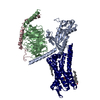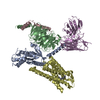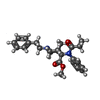+ データを開く
データを開く
- 基本情報
基本情報
| 登録情報 | データベース: PDB / ID: 7t2h | ||||||
|---|---|---|---|---|---|---|---|
| タイトル | CryoEM structure of mu-opioid receptor - Gi protein complex bound to lofentanil (LFT) | ||||||
 要素 要素 |
| ||||||
 キーワード キーワード |  MEMBRANE PROTEIN (膜タンパク質) / MEMBRANE PROTEIN (膜タンパク質) /  GPCR (Gタンパク質共役受容体) / GPCR (Gタンパク質共役受容体) /  mu-opioid receptor / lofentanil (LFT) / mitragynine pseudoindoxyl (MP) mu-opioid receptor / lofentanil (LFT) / mitragynine pseudoindoxyl (MP) | ||||||
| 機能・相同性 |  機能・相同性情報 機能・相同性情報Opioid Signalling /  spine apparatus / beta-endorphin receptor activity / morphine receptor activity / negative regulation of Wnt protein secretion / Peptide ligand-binding receptors / adenylate cyclase-inhibiting opioid receptor signaling pathway / positive regulation of appetite / G-protein activation / G protein-coupled opioid receptor activity ...Opioid Signalling / spine apparatus / beta-endorphin receptor activity / morphine receptor activity / negative regulation of Wnt protein secretion / Peptide ligand-binding receptors / adenylate cyclase-inhibiting opioid receptor signaling pathway / positive regulation of appetite / G-protein activation / G protein-coupled opioid receptor activity ...Opioid Signalling /  spine apparatus / beta-endorphin receptor activity / morphine receptor activity / negative regulation of Wnt protein secretion / Peptide ligand-binding receptors / adenylate cyclase-inhibiting opioid receptor signaling pathway / positive regulation of appetite / G-protein activation / G protein-coupled opioid receptor activity / spine apparatus / beta-endorphin receptor activity / morphine receptor activity / negative regulation of Wnt protein secretion / Peptide ligand-binding receptors / adenylate cyclase-inhibiting opioid receptor signaling pathway / positive regulation of appetite / G-protein activation / G protein-coupled opioid receptor activity /  filamin binding / G protein-coupled opioid receptor signaling pathway / regulation of cellular response to stress / G alpha (i) signalling events / behavioral response to ethanol / adenylate cyclase-inhibiting G protein-coupled acetylcholine receptor signaling pathway / negative regulation of nitric oxide biosynthetic process / negative regulation of adenylate cyclase-activating G protein-coupled receptor signaling pathway / filamin binding / G protein-coupled opioid receptor signaling pathway / regulation of cellular response to stress / G alpha (i) signalling events / behavioral response to ethanol / adenylate cyclase-inhibiting G protein-coupled acetylcholine receptor signaling pathway / negative regulation of nitric oxide biosynthetic process / negative regulation of adenylate cyclase-activating G protein-coupled receptor signaling pathway /  neuropeptide binding / negative regulation of cAMP-mediated signaling / neuropeptide binding / negative regulation of cAMP-mediated signaling /  regulation of NMDA receptor activity / positive regulation of neurogenesis / regulation of NMDA receptor activity / positive regulation of neurogenesis /  eating behavior / negative regulation of cytosolic calcium ion concentration / transmission of nerve impulse / G-protein alpha-subunit binding / neuropeptide signaling pathway / Adenylate cyclase inhibitory pathway / GABA-ergic synapse / eating behavior / negative regulation of cytosolic calcium ion concentration / transmission of nerve impulse / G-protein alpha-subunit binding / neuropeptide signaling pathway / Adenylate cyclase inhibitory pathway / GABA-ergic synapse /  voltage-gated calcium channel activity / positive regulation of protein localization to cell cortex / regulation of cAMP-mediated signaling / positive regulation of cAMP-mediated signaling / D2 dopamine receptor binding / G protein-coupled serotonin receptor binding / cellular response to forskolin / regulation of mitotic spindle organization / sensory perception of pain / dendrite membrane / presynaptic modulation of chemical synaptic transmission / adenylate cyclase-inhibiting G protein-coupled receptor signaling pathway / voltage-gated calcium channel activity / positive regulation of protein localization to cell cortex / regulation of cAMP-mediated signaling / positive regulation of cAMP-mediated signaling / D2 dopamine receptor binding / G protein-coupled serotonin receptor binding / cellular response to forskolin / regulation of mitotic spindle organization / sensory perception of pain / dendrite membrane / presynaptic modulation of chemical synaptic transmission / adenylate cyclase-inhibiting G protein-coupled receptor signaling pathway /  excitatory postsynaptic potential / dendrite cytoplasm / locomotory behavior / Regulation of insulin secretion / G protein-coupled receptor activity / G protein-coupled receptor binding / G-protein beta/gamma-subunit complex binding / Olfactory Signaling Pathway / Activation of the phototransduction cascade / adenylate cyclase-modulating G protein-coupled receptor signaling pathway / G beta:gamma signalling through PLC beta / Presynaptic function of Kainate receptors / Thromboxane signalling through TP receptor / G-protein activation / G protein-coupled acetylcholine receptor signaling pathway / Activation of G protein gated Potassium channels / Inhibition of voltage gated Ca2+ channels via Gbeta/gamma subunits / Prostacyclin signalling through prostacyclin receptor / Glucagon signaling in metabolic regulation / G beta:gamma signalling through CDC42 / ADP signalling through P2Y purinoceptor 12 / G beta:gamma signalling through BTK / Synthesis, secretion, and inactivation of Glucagon-like Peptide-1 (GLP-1) / Sensory perception of sweet, bitter, and umami (glutamate) taste / photoreceptor disc membrane / response to peptide hormone / Adrenaline,noradrenaline inhibits insulin secretion / Glucagon-type ligand receptors / Vasopressin regulates renal water homeostasis via Aquaporins / G alpha (z) signalling events / cellular response to catecholamine stimulus / Glucagon-like Peptide-1 (GLP1) regulates insulin secretion / ADORA2B mediated anti-inflammatory cytokines production / sensory perception of taste / ADP signalling through P2Y purinoceptor 1 / adenylate cyclase-activating dopamine receptor signaling pathway / G beta:gamma signalling through PI3Kgamma / cellular response to prostaglandin E stimulus / Cooperation of PDCL (PhLP1) and TRiC/CCT in G-protein beta folding / GPER1 signaling / G-protein beta-subunit binding / GDP binding / Inactivation, recovery and regulation of the phototransduction cascade / excitatory postsynaptic potential / dendrite cytoplasm / locomotory behavior / Regulation of insulin secretion / G protein-coupled receptor activity / G protein-coupled receptor binding / G-protein beta/gamma-subunit complex binding / Olfactory Signaling Pathway / Activation of the phototransduction cascade / adenylate cyclase-modulating G protein-coupled receptor signaling pathway / G beta:gamma signalling through PLC beta / Presynaptic function of Kainate receptors / Thromboxane signalling through TP receptor / G-protein activation / G protein-coupled acetylcholine receptor signaling pathway / Activation of G protein gated Potassium channels / Inhibition of voltage gated Ca2+ channels via Gbeta/gamma subunits / Prostacyclin signalling through prostacyclin receptor / Glucagon signaling in metabolic regulation / G beta:gamma signalling through CDC42 / ADP signalling through P2Y purinoceptor 12 / G beta:gamma signalling through BTK / Synthesis, secretion, and inactivation of Glucagon-like Peptide-1 (GLP-1) / Sensory perception of sweet, bitter, and umami (glutamate) taste / photoreceptor disc membrane / response to peptide hormone / Adrenaline,noradrenaline inhibits insulin secretion / Glucagon-type ligand receptors / Vasopressin regulates renal water homeostasis via Aquaporins / G alpha (z) signalling events / cellular response to catecholamine stimulus / Glucagon-like Peptide-1 (GLP1) regulates insulin secretion / ADORA2B mediated anti-inflammatory cytokines production / sensory perception of taste / ADP signalling through P2Y purinoceptor 1 / adenylate cyclase-activating dopamine receptor signaling pathway / G beta:gamma signalling through PI3Kgamma / cellular response to prostaglandin E stimulus / Cooperation of PDCL (PhLP1) and TRiC/CCT in G-protein beta folding / GPER1 signaling / G-protein beta-subunit binding / GDP binding / Inactivation, recovery and regulation of the phototransduction cascade /  heterotrimeric G-protein complex / positive regulation of nitric oxide biosynthetic process / G alpha (12/13) signalling events / heterotrimeric G-protein complex / positive regulation of nitric oxide biosynthetic process / G alpha (12/13) signalling events /  extracellular vesicle / signaling receptor complex adaptor activity / Thrombin signalling through proteinase activated receptors (PARs) / retina development in camera-type eye / extracellular vesicle / signaling receptor complex adaptor activity / Thrombin signalling through proteinase activated receptors (PARs) / retina development in camera-type eye /  GTPase binding / GTPase binding /  presynaptic membrane / phospholipase C-activating G protein-coupled receptor signaling pathway / Ca2+ pathway / presynaptic membrane / phospholipase C-activating G protein-coupled receptor signaling pathway / Ca2+ pathway /  細胞皮質 / midbody / G alpha (i) signalling events / positive regulation of cytosolic calcium ion concentration / fibroblast proliferation 細胞皮質 / midbody / G alpha (i) signalling events / positive regulation of cytosolic calcium ion concentration / fibroblast proliferation類似検索 - 分子機能 | ||||||
| 生物種 |   Homo sapiens (ヒト) Homo sapiens (ヒト)  Mus musculus (ハツカネズミ) Mus musculus (ハツカネズミ) | ||||||
| 手法 |  電子顕微鏡法 / 電子顕微鏡法 /  単粒子再構成法 / 単粒子再構成法 /  クライオ電子顕微鏡法 / 解像度: 3.2 Å クライオ電子顕微鏡法 / 解像度: 3.2 Å | ||||||
 データ登録者 データ登録者 | Seven, A.B. / Qu, Q. / Huang, W. / Robertson, M.J. / Kobilka, B.K. / Skiniotis, G. | ||||||
| 資金援助 |  米国, 1件 米国, 1件
| ||||||
 引用 引用 |  ジャーナル: Nat Chem Biol / 年: 2023 ジャーナル: Nat Chem Biol / 年: 2023タイトル: Insights into distinct signaling profiles of the µOR activated by diverse agonists. 著者: Qianhui Qu / Weijiao Huang / Deniz Aydin / Joseph M Paggi / Alpay B Seven / Haoqing Wang / Soumen Chakraborty / Tao Che / Jeffrey F DiBerto / Michael J Robertson / Asuka Inoue / Carl-Mikael ...著者: Qianhui Qu / Weijiao Huang / Deniz Aydin / Joseph M Paggi / Alpay B Seven / Haoqing Wang / Soumen Chakraborty / Tao Che / Jeffrey F DiBerto / Michael J Robertson / Asuka Inoue / Carl-Mikael Suomivuori / Bryan L Roth / Susruta Majumdar / Ron O Dror / Brian K Kobilka / Georgios Skiniotis /    要旨: Drugs targeting the μ-opioid receptor (μOR) are the most effective analgesics available but are also associated with fatal respiratory depression through a pathway that remains unclear. Here we ...Drugs targeting the μ-opioid receptor (μOR) are the most effective analgesics available but are also associated with fatal respiratory depression through a pathway that remains unclear. Here we investigated the mechanistic basis of action of lofentanil (LFT) and mitragynine pseudoindoxyl (MP), two μOR agonists with different safety profiles. LFT, one of the most lethal opioids, and MP, a kratom plant derivative with reduced respiratory depression in animal studies, exhibited markedly different efficacy profiles for G protein subtype activation and β-arrestin recruitment. Cryo-EM structures of μOR-Gi1 complex with MP (2.5 Å) and LFT (3.2 Å) revealed that the two ligands engage distinct subpockets, and molecular dynamics simulations showed additional differences in the binding site that promote distinct active-state conformations on the intracellular side of the receptor where G proteins and β-arrestins bind. These observations highlight how drugs engaging different parts of the μOR orthosteric pocket can lead to distinct signaling outcomes. | ||||||
| 履歴 |
|
- 構造の表示
構造の表示
| 構造ビューア | 分子:  Molmil Molmil Jmol/JSmol Jmol/JSmol |
|---|
- ダウンロードとリンク
ダウンロードとリンク
- ダウンロード
ダウンロード
| PDBx/mmCIF形式 |  7t2h.cif.gz 7t2h.cif.gz | 207.4 KB | 表示 |  PDBx/mmCIF形式 PDBx/mmCIF形式 |
|---|---|---|---|---|
| PDB形式 |  pdb7t2h.ent.gz pdb7t2h.ent.gz | 162.1 KB | 表示 |  PDB形式 PDB形式 |
| PDBx/mmJSON形式 |  7t2h.json.gz 7t2h.json.gz | ツリー表示 |  PDBx/mmJSON形式 PDBx/mmJSON形式 | |
| その他 |  その他のダウンロード その他のダウンロード |
-検証レポート
| アーカイブディレクトリ |  https://data.pdbj.org/pub/pdb/validation_reports/t2/7t2h https://data.pdbj.org/pub/pdb/validation_reports/t2/7t2h ftp://data.pdbj.org/pub/pdb/validation_reports/t2/7t2h ftp://data.pdbj.org/pub/pdb/validation_reports/t2/7t2h | HTTPS FTP |
|---|
-関連構造データ
| 関連構造データ |  25613MC  7t2gC M: このデータのモデリングに利用したマップデータ C: 同じ文献を引用 ( |
|---|---|
| 類似構造データ | 類似検索 - 機能・相同性  F&H 検索 F&H 検索 |
- リンク
リンク
- 集合体
集合体
| 登録構造単位 | 
|
|---|---|
| 1 |
|
- 要素
要素
-Guanine nucleotide-binding protein ... , 3種, 3分子 ABC
| #1: タンパク質 | 分子量: 40415.031 Da / 分子数: 1 / 由来タイプ: 組換発現 / 由来: (組換発現)   Homo sapiens (ヒト) / 遺伝子: GNAI1 Homo sapiens (ヒト) / 遺伝子: GNAI1発現宿主:   Spodoptera frugiperda (ツマジロクサヨトウ) Spodoptera frugiperda (ツマジロクサヨトウ)参照: UniProt: P63096 |
|---|---|
| #2: タンパク質 | 分子量: 37671.102 Da / 分子数: 1 / 由来タイプ: 組換発現 / 由来: (組換発現)   Homo sapiens (ヒト) / 遺伝子: GNB1 Homo sapiens (ヒト) / 遺伝子: GNB1発現宿主:   Spodoptera frugiperda (ツマジロクサヨトウ) Spodoptera frugiperda (ツマジロクサヨトウ)参照: UniProt: P62873 |
| #3: タンパク質 | 分子量: 7861.143 Da / 分子数: 1 / 由来タイプ: 組換発現 / 由来: (組換発現)   Homo sapiens (ヒト) / 遺伝子: GNG2 Homo sapiens (ヒト) / 遺伝子: GNG2発現宿主:   Spodoptera frugiperda (ツマジロクサヨトウ) Spodoptera frugiperda (ツマジロクサヨトウ)株 (発現宿主): GNG2 / 参照: UniProt: P59768 |
-抗体 / タンパク質 / 非ポリマー , 3種, 3分子 ED

| #4: 抗体 | 分子量: 27784.896 Da / 分子数: 1 / 由来タイプ: 組換発現 / 由来: (組換発現)   Mus musculus (ハツカネズミ) Mus musculus (ハツカネズミ)発現宿主:   Spodoptera frugiperda (ツマジロクサヨトウ) Spodoptera frugiperda (ツマジロクサヨトウ) |
|---|---|
| #5: タンパク質 | 分子量: 39995.105 Da / 分子数: 1 / 由来タイプ: 組換発現 / 由来: (組換発現)   Mus musculus (ハツカネズミ) / 遺伝子: Oprm1, Mor, Oprm Mus musculus (ハツカネズミ) / 遺伝子: Oprm1, Mor, Oprm発現宿主:   Spodoptera frugiperda (ツマジロクサヨトウ) Spodoptera frugiperda (ツマジロクサヨトウ)参照: UniProt: P42866 |
| #6: 化合物 | ChemComp-EID /  Lofentanil Lofentanil |
-詳細
| 研究の焦点であるリガンドがあるか | Y |
|---|
-実験情報
-実験
| 実験 | 手法:  電子顕微鏡法 電子顕微鏡法 |
|---|---|
| EM実験 | 試料の集合状態: PARTICLE / 3次元再構成法:  単粒子再構成法 単粒子再構成法 |
- 試料調製
試料調製
| 構成要素 | 名称: mu-opioid receptor - Gi protein complex bound to lofentanil (LFT) タイプ: COMPLEX 詳細: mu-opioid receptor - Gi protein complex bound to lofentanil (LFT) stabilized by scFv16 Entity ID: #1-#5 / 由来: MULTIPLE SOURCES |
|---|---|
| 分子量 | 実験値: NO |
| 由来(天然) | 生物種:   Mus musculus (ハツカネズミ) Mus musculus (ハツカネズミ) |
| 由来(組換発現) | 生物種:   Spodoptera frugiperda (ツマジロクサヨトウ) Spodoptera frugiperda (ツマジロクサヨトウ) |
| 緩衝液 | pH: 7.4 |
| 試料 | 包埋: NO / シャドウイング: NO / 染色 : NO / 凍結 : NO / 凍結 : YES : YES |
急速凍結 | 凍結剤: ETHANE |
- 電子顕微鏡撮影
電子顕微鏡撮影
| 実験機器 |  モデル: Titan Krios / 画像提供: FEI Company |
|---|---|
| 顕微鏡 | モデル: FEI TITAN KRIOS |
| 電子銃 | 電子線源 : :  FIELD EMISSION GUN / 加速電圧: 300 kV / 照射モード: FLOOD BEAM FIELD EMISSION GUN / 加速電圧: 300 kV / 照射モード: FLOOD BEAM |
| 電子レンズ | モード: BRIGHT FIELD Bright-field microscopy / 最大 デフォーカス(公称値): 2000 nm / 最小 デフォーカス(公称値): 1000 nm Bright-field microscopy / 最大 デフォーカス(公称値): 2000 nm / 最小 デフォーカス(公称値): 1000 nm |
| 撮影 | 電子線照射量: 56 e/Å2 / 検出モード: COUNTING フィルム・検出器のモデル: GATAN K2 SUMMIT (4k x 4k) |
- 解析
解析
| ソフトウェア | 名称: PHENIX / バージョン: 1.17.1_3660: / 分類: 精密化 | ||||||||||||||||||||||||
|---|---|---|---|---|---|---|---|---|---|---|---|---|---|---|---|---|---|---|---|---|---|---|---|---|---|
| EMソフトウェア | 名称: SerialEM / カテゴリ: 画像取得 | ||||||||||||||||||||||||
CTF補正 | タイプ: PHASE FLIPPING AND AMPLITUDE CORRECTION | ||||||||||||||||||||||||
3次元再構成 | 解像度: 3.2 Å / 解像度の算出法: FSC 0.143 CUT-OFF / 粒子像の数: 152809 / 対称性のタイプ: POINT | ||||||||||||||||||||||||
| 拘束条件 |
|
 ムービー
ムービー コントローラー
コントローラー




 PDBj
PDBj






























